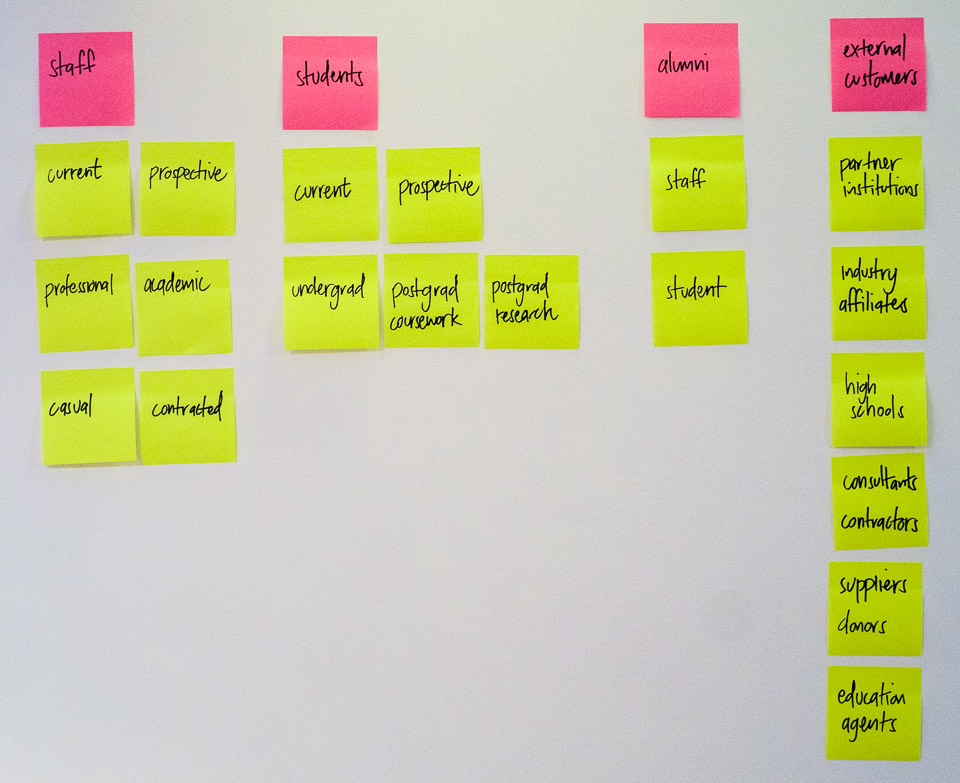
What is it?
A fast way to define customer groups in a workshop. Customer Archetype Maps describe the needs, behaviours and pain points for different kinds of customers.
Quickly, on definitions:
- A behavioural archetype describes common behaviour and tasks exhibited by customers with similar needs.
- Personas package behaviours and motivations of a customer group into a believable caricature.
- Market segments describes groups of people with similar demographics, attitudes, and socio-economic status. They infer customer behaviours.
How long should it take?
1-3 hours with 2-6 participants.
If there are more than six participants, break the workshop into smaller groups.
Use it when…
- You want a high level view of customer behaviour, motivations and pain points
- There is no time for customer research, and no shared understanding from existing research
- You want to change perspective from inside-out (market segments) to outside-in (customer behaviour)
- You’re redesigning an existing system
What it isn’t
- A replacement research-based personas
- An alternative to Experience Mapping. It’s similar, but Experience Mapping is a research method, not a workshop activity
Why use it?
Research methods like Experience Mapping and Personas need a deep understanding of customers. When you’re working with folks that aren’t close to customers, using those methods is tedious and unhelpful.
With best intentions, discussion gravitates toward the business. People talk of how customers ought to interact, not how customers actually behave. That can be useful, but business process mapping is a better tool for that. It’s a similar conundrum for Personas. Good ones reveal insight from research in a way that humanises the design process. Good personas aren’t created in workshops. They’re created by researchers. In a workshop, it’s too easy to wind up talking about market segments. That can be useful – but it’s more about the organisation than the customer.
Archetype Mapping answers critical questions very quickly:
- Who are the customers and what are they trying to achieve?
- What are the problems to solve (or opportunities to explore)?
Facilitator’s Guide
Agree on basic customer groupings
First, articulate a limited number of easy to understand groups. These are later used for ‘mapping’ – to explore problems and opportunities for each group.
A good start is to ask:
Who uses your product or service?
Post-up all the suggested names, then cluster into meaningful groupings and give each group a name.
If the product is mass market – meaning that ‘everybody’ is a customer – you may get better outcomes by having participants define goals and actions first. Then, come back to customer groups later.

Define goals and actions
Now you’ve agreed on customer groups. For each group, take a few minutes and post-up all the common actions or tasks performed anyone that belongs to the parent group e.g. all kinds of students. Again, arrange similar items into clusters, and describe each with a name. Eventually, several kinds of customer will have been defined by their needs, behaviour and tasks. Those are Behavioural Archetypes!

Map the barriers and missed opportunities
Understanding problems to solve – or opportunities to explore – is the beginning of solution design. Knowing customer needs and blockers through deep research is best. When working high level during a workshop, it’s enough to know only the main things that get in their way. Usually, participants will have a reasonable sense of what those are.
Mapping them out can be as simple as asking:
For this kind of customer, with these primary goals, what are all the things that get in the way of success?
Expect a flurry of responses. Then ask the optional question:
Given what we know about their needs, what opportunities have we we missed to make their life easier?
That part is optional. It’s useful as a parking lot for ideas that come out of the discussion. Stakeholders often say things like “we should be doing x with y in a situation like z“. Posting those as ‘missed opportunities’ stops the conversation from meandering into potential solutions.
By now, you’ve painted a picture of your customers. You know their goals and behaviours, as well as the pain points and missed opportunities. That’s gold-dust for future customer centred design activities.
Going a step further
Try synthesising all the actions and behaviours into a set of universal goals. In the same vein, analyse all the pain points into some common themes. This completes the customer picture. Use it in contrast with business goals and objectives. Consider business and customers together, to articulate design challenges that guide solution exploration.
